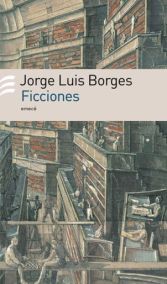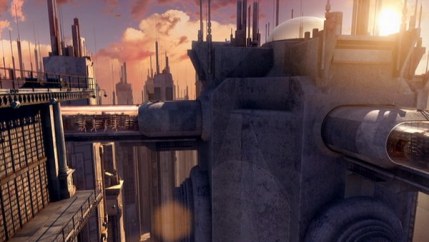![]() Some of my favourite fictional libraries tend to be very improbable: magical books in Harry Potter, medieval mazes in the Name of the Rose, Escherian bookshelves in American McGee’s Alice, a planet library in Doctor Who…
Some of my favourite fictional libraries tend to be very improbable: magical books in Harry Potter, medieval mazes in the Name of the Rose, Escherian bookshelves in American McGee’s Alice, a planet library in Doctor Who…
Some artists who decided to play with paradoxical, metaphysical libraries have been inspired by The Library of Babel, by Jorge Luis Borges (1941).

In Borges’s short story, the whole universe is a giant library containing all possible books, shelved in hexagonal rooms. While such a library is theoretically finite, the narrator, a dying inhabitant of the library, says he believes the library to be infinite, consisting in repeating sequences of all possible books of 410 pages of 40 lines of 80 signs among the 25 possible signs. Thus there are at least 25 power 1312000 books in the library!
Most books are complete nonsense – and some think it is fruitless to search for meaning in them – but since every possible book exists in the library, the latter also contains every possible, true and false autobiographies… Some men began to search for predictions, even if the probability of finding a book describing their own life is close to zero. Most humans, knowing they couldn’t tell the deceitful from the true, fell in suicidal despair, while some cultist librarians destroyed books they thought were nonsense.
One cannot but think of the infinite monkey theorem, stating that given an infinite amount of time a monkey typing at random would write the complete works of Shakespeare. Some websites, generating random texts, try to emulate the Babel library.
A Shakespearian play will indeed appear in the library of Babel, but the latter is useless in terms of provided information. Only the imagination of Shakespeare allowed Hamlet or Macbeth to be “found”.
Borges himself has been inspired by Kurd Lasswitz and his 1904 story “The Universal Library” (“Die Universalbibliothek”).
Erik Desmazières created some Piranesian artworks to accompany reprints of the Library of Babel.

Some hexagonal vertigo:


John Coultard says in an article:
The volumes in Borges’ Library don’t contain illustrations but one of them at least would describe this very book. Another would describe this book with a minor variation in one of the plates; another would describe MC Escher’s depictions of the Library, and Piranesi’s, and Salvador Dalí’s, and on and on…
French photographer Jean-François Rauzier also took inspiration from Borges when he created some of his stunning hyper-photographs, Bibliothèques Idéales (Ideal Libraries).

Here, the hexagonal rooms described by Borges find a beehive-like echo, enhancing the nearly industrial aspect of such an exhaustive library.
Other stunning creations by Rauzier here and there.

To go back to my fictional libraries list, two of them were clearly inspired by the library of Babel.
The medieval, labyrinthine library in the Name of the Rose is said by author Umberto Eco to have been inspired by Borges’s short story. This aspect was cleverly enhanced by the Piranesian photography of the movie.

The planet library in Silence in the Library, Doctor Who, series 4 episode 8 might also be a homage to the universe library.
 The difference here is that not every possible book exists, “only” all or most books ever written.
The difference here is that not every possible book exists, “only” all or most books ever written.
In Interstellar, /BEWARE OF THE SPOILER/,
the multidimensional library the hero uses to communicate with his daughter through time is also a reference to Borges, as stated here.

The Dream library in the Sandman comic book series, by Neil Gaiman (1989 onwards), wouldn’t have existed without the library of Babel, claims Neil Gaiman in El Pais.
Lucien’s library contains all the books people have ever dreamt of, even if they have not written them.
There, you can find potential books such as the Lost Road by Tolkien – a dream which sadly never came true.

I don’t know if Genevieve Cogman has been inspired by Borges, but I loved her ideas in The Invisible Library, 2015.
The protagonist, Irene, is a Librarian working for the Library, a giant center in a universe which exists in a different dimension than the other universes of the multiverse. Irene is a spy, her job is to go to parallel universes to find either “unique books”- books unique to their universe, which are very special – or very rare or significant variants of books. For instance, the Grimm fairy tales might exist in slightly – or vastly – different versions according to the universe in which they were written.
I definitely love how this idea of a total or universal library can still be declined in original, interesting ideas by creators. And I have to add all of those libraries to my list of libraries to visit – maybe not the actual Library of Babel, which drove countless beings to despair.



Great collection. It made me think of a yet another fantastic library in a moving Croatian comic:
“Sve knjige svijeta” (all the books in the world)
http://imgur.com/a/gsnka
Thank you very much for sharing this comic with me – indeed it is very moving…
Such a library does exist. libraryofbabel.info
Thanks for the link!